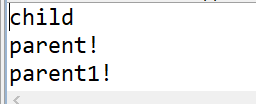動手動腦4
1.TestInherits.java
public class TestInherits
{
public static void main(String args[])
{
Child c = new Child();
}
}
輸出結果:
修改程式碼:

輸出結果:
結論:通過 super 呼叫基類構造方法,必須是子類構造方法中的第一個語句。
2. 為什麼子類的構造方法在執行之前,必須呼叫父類的構造方法?能不能反過來?為什麼不能反過來?
構造方法用於對基類的初始化。當構造一個物件時,先呼叫建構函式對成員函式和成員變數進行初始化,。子類繼承了父類的成員函式和成員變數,若不進行呼叫,則不會對父類的初始化。
3.ExplorationJDKSource.java
public class ExplorationJDKSource {
/**
* @param args
*/
public static void main(String[] args) {
System.out.println(new A());
}
}
class A{}
在編譯原始碼時,當遇到沒有父類的類時,編譯器會定義的預設的父類(一般為Object),public void println(Object x),這一方法內部呼叫了String類的valueOf方法。valueOf
public String toString() {
return getClass().getName() +"@" +
Integer.toHexString(hashCode());
}
4.
public class Fruit
{
public String toString()
{
return "Fruit toString.";
}
public static void main(String args[])
{
Fruit f=new Fruit();
System.out.println("f="+f);
// System.out.println("f="+f.toString());
}
}
輸出結果:
結論:在“+”運算中,當任何一個物件與一個String物件,連線時,會隱式地呼叫其toString()方法,預設情況下,此方法返回“類名 @ + hashCode”。為了返回有意義的資訊,子類可以重寫toString()方法。
5. 方法覆蓋
public class parents {
public void parents(){
System.out.println("parent!");
}
public void parent1(){
System.out.println("parent1!");
}
}
public class child extends parents {
public void child(){
super.parents();
}
public void parents(){
System.out.println("child");
}
public static void main(String[]args){
child ch=new child();
ch.parents();
ch.child();
ch.parent1();
}
}
輸出結果:

6. TestInstanceof.Java
public class TestInstanceof
{
public static void main(String[] args)
{
//宣告hello時使用Object類,則hello的編譯型別是Object,Object是所有類的父類
//但hello變數的實際型別是String
Object hello = "Hello";
//String是Object類的子類,所以返回true。
System.out.println("字串是否是Object類的例項:" + (hello instanceof Object));
//返回true。
System.out.println("字串是否是String類的例項:" + (hello instanceof String));
//返回false。
System.out.println("字串是否是Math類的例項:" + (hello instanceof Math));
//String實現了Comparable介面,所以返回true。
System.out.println("字串是否是Comparable介面的例項:" + (hello instanceof Comparable));
String a = "Hello";
//String類既不是Math類,也不是Math類的父類,所以下面程式碼編譯無法通過
//System.out.println("字串是否是Math類的例項:" + (a instanceof Math));
}
}
輸出結果:
7. 型別轉換
class Mammal{}
class Dog extends Mammal {}
class Cat extends Mammal{}
public class TestCast
{
public static void main(String args[])
{
Mammal m;
Dog d=new Dog();
Cat c=new Cat();
m=d;
//d=m;
d=(Dog)m;
//d=c;
//c=(Cat)m;
}
}
結果:d=m; d=c;有錯誤,c=(Cat)m正確
結論:在繼承中,子類可以自動轉換成父類,但父類轉換成子類只有引用型別真正身份才會轉換成功,否則會失敗。
8.
public class ParentChildTest {
public static void main(String[] args) {
Parent parent=new Parent();
parent.printValue();
Child child=new Child();
child.printValue();
parent=child;
parent.printValue();
parent.myValue++;
parent.printValue();
((Child)parent).myValue++;
parent.printValue();
}
}

結論:由此可得Java的一些語法特性(多型):
當子類與父類擁有一樣的方法,並且讓一個父類變數引用一個子類物件時,到底呼叫哪個方法,由物件自己的“真實”型別所決定,這就是說:物件是子型別的,它就呼叫子型別的方法,是父型別的,它就呼叫父型別的方法。
如果子類與父類有相同的欄位,則子類中的欄位會代替或隱藏父類的欄位,子類方法中訪問的是子類中的欄位(而不是父類中的欄位)。如果子類方法確實想訪問父類中被隱藏的同名欄位,可以用super關鍵字來訪問它。 如果子類被當作父類使用,則通過子類訪問的欄位是父類的。
因此,我們進行程式設計時應避免子類與父類同名的欄位!
9.
public class TestPolymorphism
{
public static void main(String args[])
{
Parent p=new Parent();
p.Introduce();
System.out.println(p.value);
p=new Son();
p.Introduce();
System.out.println(p.value);
p=new Daughter();
p.Introduce();
System.out.println(p.value);
}
多型程式碼:當多個類實現同一介面(或派生自同一抽象類)時,針對這些類所建立的物件呼叫介面所定義的方法時,會分別呼叫相應的類的具體實現程式碼。
